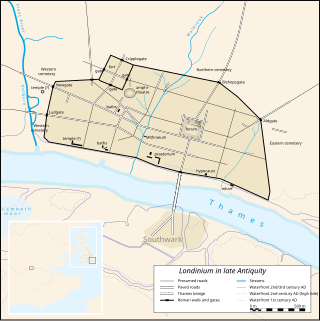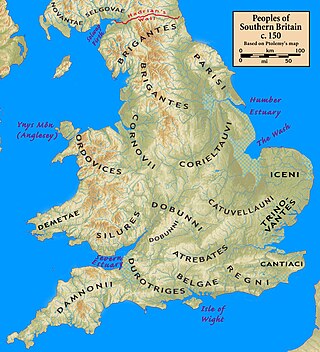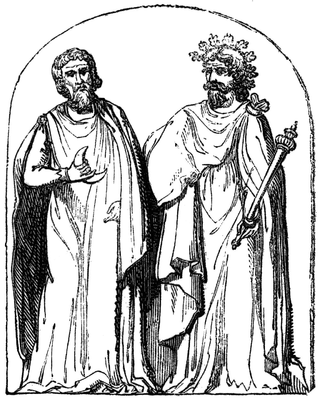Related Research Articles

Boudica or Boudicca was a queen of the ancient British Iceni tribe, who led a failed uprising against the conquering forces of the Roman Empire in AD 60 or 61. She is considered a British national heroine and a symbol of the struggle for justice and independence.

Roman Britain was the territory that became the Roman province of Britannia after the Roman conquest of Britain, consisting of a large part of the island of Great Britain. The occupation lasted from AD 43 to AD 410.

The 40s decade ran from January 1, AD 40, to December 31, AD 49.

The 60s decade ran from January 1, AD 60, to December 31, AD 69.
AD 61 (LXI) was a common year starting on Thursday of the Julian calendar. At the time, it was known as the Year of the Consulship of Turpilianus and Caesennius. The denomination AD 61 for this year has been used since the early medieval period, when the Anno Domini calendar era became the prevalent method in Europe for naming years.
AD 65 (LXV) was a common year starting on Tuesday of the Julian calendar. At the time, it was known as the Year of the Consulship of Nerva and Vestinus. The denomination AD 65 for this year has been used since the early medieval period, when the Anno Domini calendar era became the prevalent method in Europe for naming years.

Gaius Suetonius Paulinus was a Roman general best known as the commander who defeated Boudica and her army during the Boudican revolt.

Londinium, also known as Roman London, was the capital of Roman Britain during most of the period of Roman rule. Most twenty-first century historians think that it was originally a settlement established shortly after the Claudian invasion of Britain, on the current site of the City of London around 47–50 AD, but some defend an older view that the city originated in a defensive enclosure constructed during the Claudian invasion in 43 AD. Its earliest securely-dated structure is a timber drain of 47 AD. It sat at a key ford at the River Thames which turned the city into a road nexus and major port, serving as a major commercial centre in Roman Britain until its abandonment during the 5th century.

Mancetter is a village and civil parish in North Warwickshire, England, where Watling Street crosses the River Anker. The population was 2,339 at the 2011 census. It is on the B4111 road towards Hartshill and Nuneaton, near Atherstone.

The Iceni or Eceni were an ancient tribe of eastern Britain during the Iron Age and early Roman era. Their territory included present-day Norfolk and parts of Suffolk and Cambridgeshire, and bordered the area of the Corieltauvi to the west, and the Catuvellauni and Trinovantes to the south. In the Roman period, their capital was Venta Icenorum at modern-day Caistor St Edmund.
Catus Decianus was the procurator of Roman Britain in AD 60 or 61. Tacitus blames his "rapacity" in part for provoking the rebellion of Boudica. Cassius Dio says he confiscated sums of money which had been given by the emperor Claudius to leading Britons, declaring them to be loans to be repaid with interest.

Gaius Julius Alpinus Classicianus was procurator of Roman Britain from 61 to his death in 65.
Julius Indus was a nobleman of the Gaulish Treveri tribe. In 21 CE he helped the Romans put down a rebellion of the Treveri and Aedui. Indus had a personal vendetta with one of the leaders in the revolt, Julius Florus. Culminating in a confrontation between the two in the Ardennes forest. During this fight, Indus killed Florus. His regiment may have been involved in the Roman invasion of Britain, and was certainly posted at Corinum (Cirencester) in the mid-to-late 1st century. His daughter, Julia Pacata, married the procurator of Roman Britain, Gaius Julius Alpinus Classicianus, and buried him in London in 65 CE.

The Roman client kingdoms in Britain were native tribes which chose to align themselves with the Roman Empire because they saw it as the best option for self-preservation or for protection from other hostile tribes. Alternatively, the Romans created some client kingdoms when they felt influence without direct rule was desirable. Client kingdoms were ruled by client kings. In Latin these kings were referred to as rex sociusque et amicus, which translates to "king, ally, and friend". The type of relationships between client kingdoms and Rome was reliant on the individual circumstances in each kingdom.
Crixus was a Gallic gladiator and military leader in the Third Servile War between the Roman Republic and rebel slaves. Born in Gaul, he was enslaved by the Romans under unknown circumstances and trained as a gladiator in Capua. His name means "one with curly hair" in Gaulish.
Events from the 1st century in Roman Britain.

Pottery was produced in enormous quantities in ancient Rome, mostly for utilitarian purposes. It is found all over the former Roman Empire and beyond. Monte Testaccio is a huge waste mound in Rome made almost entirely of broken amphorae used for transporting and storing liquids and other products – in this case probably mostly Spanish olive oil, which was landed nearby, and was the main fuel for lighting, as well as its use in the kitchen and washing in the baths.

A druid was a member of the high-ranking priestly class in ancient Celtic cultures. Druids were religious leaders as well as legal authorities, adjudicators, lorekeepers, medical professionals and political advisors. Druids left no written accounts. While they were reported to have been literate, they are believed to have been prevented by doctrine from recording their knowledge in written form. Their beliefs and practices are attested in some detail by their contemporaries from other cultures, such as the Romans and the Greeks.

Boadicea and Her Daughters is a bronze sculptural group in London representing Boudica, queen of the Celtic Iceni tribe, who led an uprising in Roman Britain. It is located to the north side of the western end of Westminster Bridge, near Portcullis House and Westminster Pier, facing Big Ben and the Palace of Westminster across the road. It is considered the magnum opus of its sculptor, the English artist and engineer Thomas Thornycroft. Thornycroft worked on it from 1856 until shortly before his death in 1885, sometimes assisted by his son William Hamo Thornycroft, but it was not erected in its current position until 1902.

The Boudican revolt was an armed uprising by native Celtic Britons against the Roman Empire during the Roman conquest of Britain. It took place circa AD 60–61 in the Roman province of Britain, and was led by Boudica, the Queen of the Iceni tribe. The uprising was motivated by the Romans' failure to honour an agreement they had made with Boudica's husband, Prasutagus, regarding the succession of his kingdom upon his death, and by the brutal mistreatment of Boudica and her daughters by the occupying Romans.
References
- ↑ Collingridge, Vanessa (2012-09-30). Boudica. Random House. p. 284. ISBN 978-1-4464-4501-3.
- ↑ Watts, Dorothy (2005-10-09). Boudicca's Heirs: Women in Early Britain. Routledge. pp. 35–36. ISBN 978-1-134-46309-1.
- ↑ Bédoyère, Guy de la (2015-07-28). The Real Lives of Roman Britain. Yale University Press. pp. 44–45. ISBN 978-0-300-21403-1.